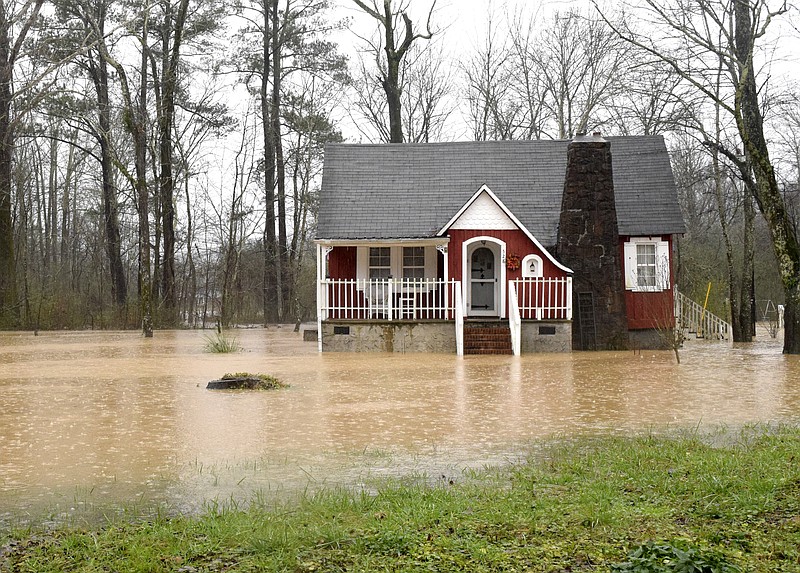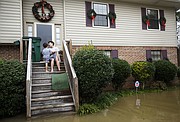Preventative steps
* Install a sump pump to keep water from gathering under or around your home.* Add a perimeter drain to collect rising groundwater and carry it away from the foundation.* Design your landscaping correctly. Make sure the ground slopes away from your home to carry the water off.* The top of the home’s foundation should be a minimum of 8 inches above the soil.* Plants should be placed a minimum of 2 feet from the foundation.Source: HGTV
Bryon Coleman knew his basement had a slight water problem.
During truly monumental rains, the "man cave" down there might get a little damp, but a drain in one corner would quickly funnel the water out of the house.
Then came 4 inches of rain on Christmas Day.
"We got up that morning and we were having Christmas with the boys when, all of a sudden, I told my wife, 'I need to go down to the basement,'" he recalls. "I didn't go down there early enough."
The basement in his 1938 home in the Belvoir neighborhood has a concrete floor, but he's covered it in carpet tile that locks together like a puzzle, no glue involved. Opening the basement door on Christmas, he gazed into the room "and there was 2 inches of water in one end of the basement."
"I turned and closed the door," he says.
Coleman is comparatively lucky. The drain eventually took care of the water and then he had to pull up the carpet tiles, clean them and put them some place to thoroughly dry - as well as sop up whatever dampness remained on the basement floor.
But some folks in the Chattanooga weren't as fortunate after the record-setting rainfall in December. For some, the problem was relatively small and meant getting out brooms and mops, maybe opening some windows and turning up the heat to dry things out. For others, it meant using a water vac to suck up the water and funnel it outside.
Still others, however, had to rip up carpet or wooden flooring, some of which had be tossed for good. In worse scenarios, drywall had to be pulled down and replaced because water had seeped upward inside it, providing a perfect environment for growing mold and mildew. And, in worst-of-all moments, the water had cracked foundation walls or caused foundations to actually sag.
Flooding is the most common natural disaster in the United States, causing $2.7 billion in losses between 2001 and 2010, according to the National Flood Insurance Program, a government-sponsored pool that provides flood insurance to home owners. But there are steps homeowners can take to assess the danger of water damage to their homes and, in some cases, to repair it themselves.
"What we do, an educated homeowner could do," says Bernard Foster, chief administration officer at B-Dry Waterproofing Systems, which is headquartered in Knoxville and operates in the Chattanooga and North Georgia area.
Homeowners must understand that "once it starts, these problems don't go away," he says. What happens is, if water is getting in during a deluge, after time it begins to find its way inside "with lighter and lighter rainfall because the water has found a way in," Foster says.
And yes, B-Dry has been "very busy" since the December rains, he says. A rule of thumb about when to call a professional: Once the situation gets to the point where you're looking at possible water damage to the interior of your home or the actual foundation, he says.
So to protect your house, first look at where it is sitting "in relation to any water source," Foster says. For instance, if you have a pond on your property, the ground around it is already saturated with water so "if it rains, it's just that much less rain for it to really be putting pressure on the house."
Then look at your home in relation to the rest of your neighborhood, for example, "whether it's at the top of a hill or at the bottom of hill," Foster says. If you notice that you're in a hole, so to speak, you should consider grading your property in such a way that water will flow around your home as much as possible, he says.
Third, make sure your gutters and downspouts are clean and moving water away from your foundation house. A general rule of thumb is the water should end up anywhere from 5 to 10 feet away, depending on the slope of your yard, Foster says.
Another step: Watch your mulch. "People will take great pride in landscaping and, year after year without fail, every spring I see people go out get a big thing of pine mulch or hardwood mulch" and put it in the beds around their homes, he says.
The problem is, some homeowners never remove last year's layer of mulch so, in a few years, they've got a 6- or 7-inch layer of mulch that's so dangerously high, it's close or even over the sill of the hosue, the line where the foundation meets the wooden frame. It's fine to put new mulch down every spring, Foster says, just make sure you remove the previous year's.
And finally, if you have a window or door that's at ground level or below or you know there's an area where water tends to seep in during heavy rains, take steps to prevent it. If heavy rains are forecast, he says, use sandbags or plastic to seal those places.
Inside the house, if your basement walls are not covered by drywall or paneling, you can use a waterproof sealant to close cracks, wall joints and floors. This is something you can do yourself and costs about $1,700 for a 20-by-30-foot basement, according to houselogic.com. But if you see cracks in the walls "that are thicker than a dime, you need to call a professional," Foster says.
In some cases, a sump pump may be needed keep water from standing on your floors, underneath your house or around the foundation. A sump pump installation will run between $700 and $1,500, depending on the type of pump you choose and where it must be installed, says homeadvisor.com.
"This is the year to give yourself a better foundation," says master contractor and plumber Ed Del Grande, author of "Ed Del Grande's House Call." "Make sure your basement sump pump system is installed and working properly. If you don't have a sump pump system or if it needs to be repaired, bring it up to code to help protect your home."
If a sump pump isn't the answer, you may have to spend some cash outside your house to have a trench dug to funnel the water away from your foundation. Known as a French drain, the cost of this job averages anywhere from $10 to $50 per linear foot, according to costhelper.com.
Yes, you can install a French drain yourself but, be warned, it can be a backbreaking task that includes digging a trench that extends as far from the house as you need the water to be dumped. That can be 50 to 75 feet and, oh yes, make sure that, as you dig, you put a downward grade on the trench so the water flows easily. Then there's gravel, corrugated perforated pipes and landscape fabric to deal with.
Coleman has a French drain along the side of his home that gets the most water during rain. He installed it 27 years ago when he moved in and figures one reason his basement is getting wet is because the drain has clogged after so many years. He says he could do the job himself with a ditch-digging machine but, at 58, he figures he'll hire someone to do it.
"Maybe 30 years ago I would have done it, but , " he says.
Contact Shawn Ryan at sryan@timesfreepress.com or 423-757-6327.

